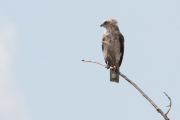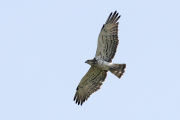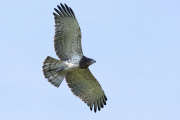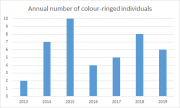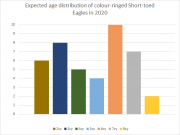Results of the colour-ringing scheme of the Short-toed Eagle in Hungary between 2013 and 2019
Gábor PAPP
Short-toed Eagle species conservation coordinator
Short-toed Eagle Working Group/MME, Hungary
Short-toed Eagle species conservation coordinator
Short-toed Eagle Working Group/MME, Hungary
The very first Short-toed Eagle was marked with aluminium ring in 1978. Between 1978 and 2013, 61 juveniles were ringed with such metal rings. Of these only one individual provided recapture data after having been detained as a 4cy in weak condition and was later released in Syria.
The colour ringing of Short-toed Eagle nestlings started in 2013 and has been continuing since then, marking two to ten birds annually. During this period, altogether 42 individuals has been ringed with individually coded rings. We use blue rings with white inscriptions starting with a capital “A” followed by two numbers.
In the past seven years, six birds have been identified by their colour rings. Considering that juveniles marked in 2019 had not provided any resightings due to the fact that they stay in the vicinity of the nest until they start migration we can say that out of 36 colour ringed birds (after four ringed juveniles in 2019 and two satellite-tagged individuals being deducted from the total of 42 birds) six colour ringed individuals were seen again at least once, which means about 17% of 36 individuals provided recapture data. Colour ringed birds were observed altogether 10 times until today and of these, four birds were seen twice. Two of them were even identified by their rings in different years. Besides correctly decoded rings, basically every year yielded partial readings on colour rings of one to three individuals. It is also worth mentioning that the members of the Short-toed Eagle group put extra efforts in trying to locate colour ringed birds during the summer since we strongly believe that the scheme can only be complete if there is a good balance between the efforts invested in ringing and ring-reading. Although ringing ten juveniles per year would be desirable, due the lack of capacity and enthusiasm among ringers it was only achieved in one year, in 2015.
Interestingly, we have no data of colour ringed 2cy birds which supports the theory of this age group tending to stay south of Europe during their first summer also backed up by satellite-tagged individuals from Western Europe and Hungary as well. It also raises the question where those positively identified (by plumage traits from quality pictures) 2cy Short-toed Eagles that we see during the summer might originate from. Most of the observed birds were in known over-summering areas but two older individuals, 4 and 5cy, respectively, turned up in suitable breeding habitats where a pair was raising chick at that time or was formerly known as an active territory. All resightings occurred during the period from July through September when most of the over-summering birds may be seen in the country. Especially, these latter observations give us hope that one day we will find a colour ringed breeding individual, however, the monitoring efforts of the past decade proved only the disappearance of breeding pairs in Hungary. In 2020, altogether 19 colour ringed Short-toed Eagles will be 6cy or older what we consider, based on data in the literature, the first year of breeding, therefore, there is a good chance that our next post on the site may deal with the very first nesting of a colour-ringed individual in Hungary.

